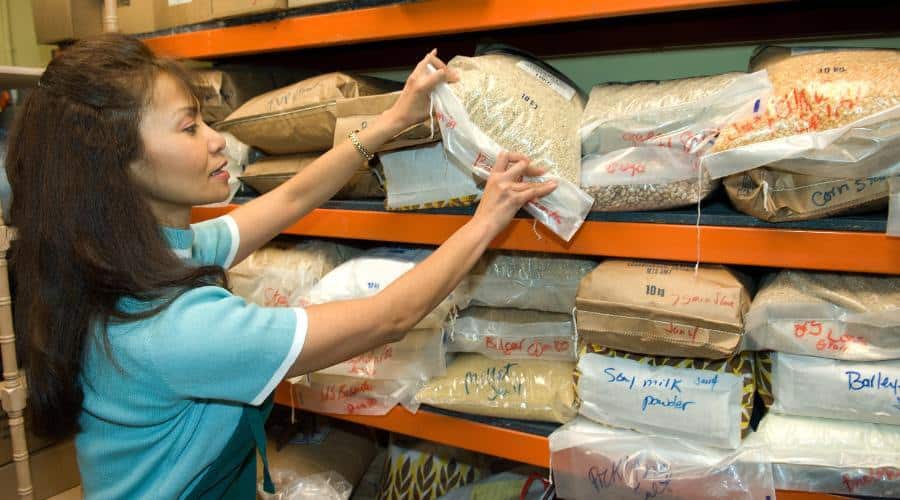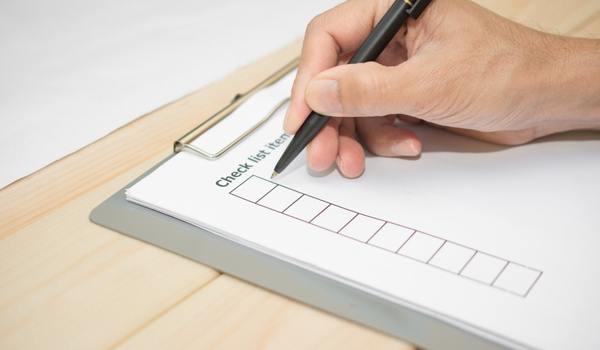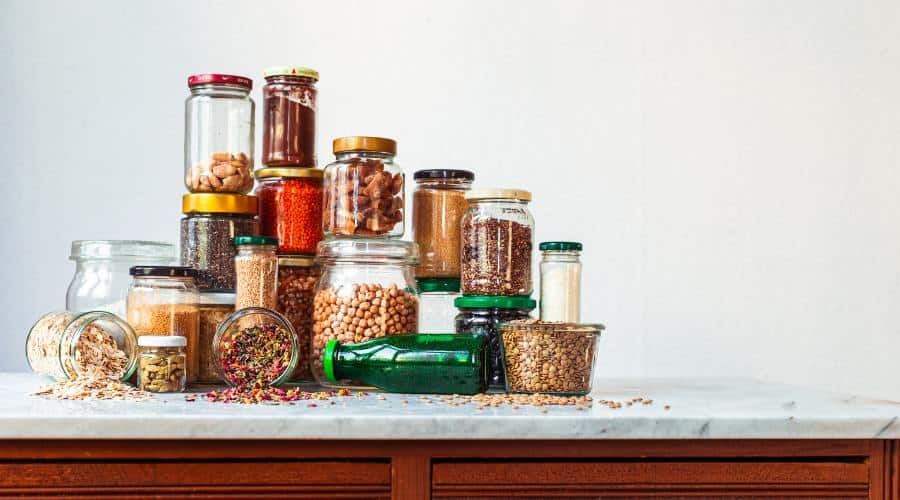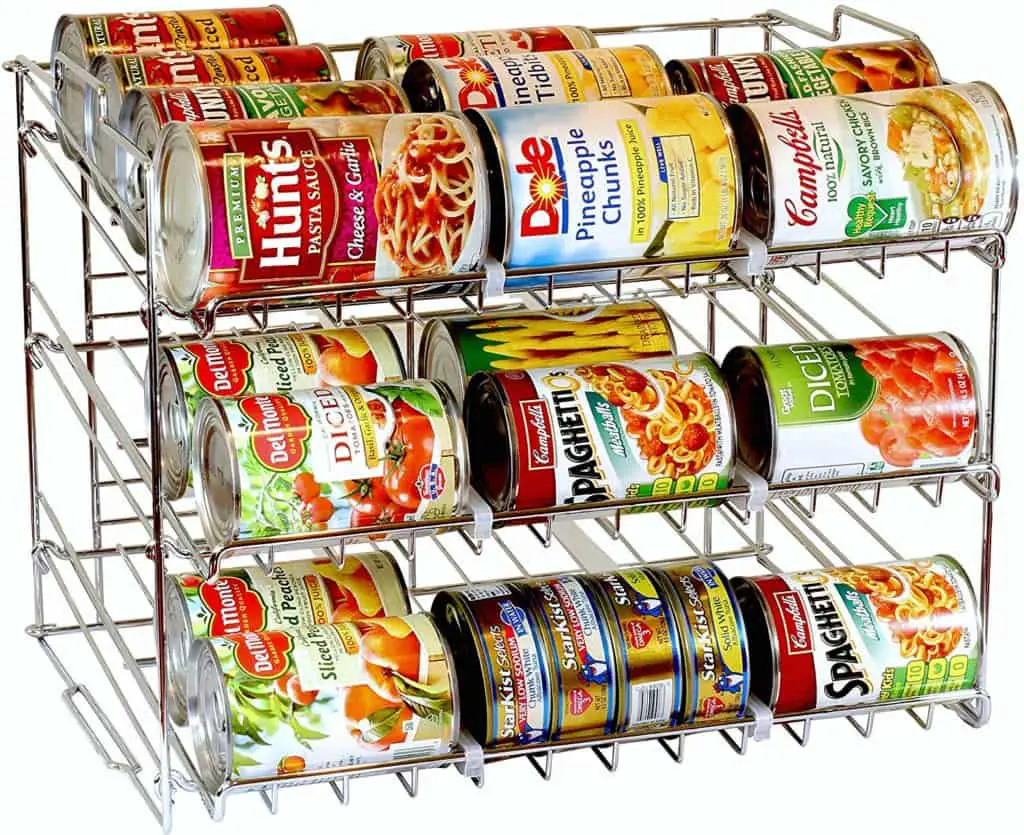It is important to organize your stored bulk foods so that you can easily find what you need later. If you don’t have an organized system that works for you then you will end up with spoiled bulk foods that are unusable. Organizing your bulk food storage should be done in conjunction with the right food storage methods (see our guide and tips for storing bulk food long-term).
How do I Organize My Bulk Food Storage?
To organize your bulk food storage effectively, label each container with the type of food it contains and the date it was stored. Use bins or shelves to keep items organized, and consider using a food rotation system to ensure that you use the oldest items first.
Here are some tips for organizing your bulk food storage:
By following these tips, you can effectively store food in bulk long-term and keep it organized for easy access. Storing food in bulk is a great way to save money, reduce waste, and ensure that you always have a supply of non-perishable items on hand. Whether you’re a prepper, a homesteader, or just someone who wants to be more self-sufficient, learning how to store food in bulk is an essential skill.
If you are looking to buy more bulk foods to add to your storage see the best places to buy bulk food online at a discount and where to find bulk food stores near you. Also, we spent hours putting together a list of the best foods for long-term storage.
Additionally, if you’re looking to expand your bulk foods make sure to check out the top 10 foods that are cheaper to buy in bulk.
1. Label Bulk Food Storage Clearly
Labeling your long-term food storage is an important step in keeping track of what you have and when it needs to be used. Here are some tips for labeling your long-term food storage:
- Use a permanent marker. Choose a permanent marker that will not fade or smudge over time. This will help you to clearly see the labels and ensure that you are using the oldest items first.
- Label the type of food and the date it was stored. Use the permanent marker to label each container with the type of food it contains and the date it was stored. This will help you to keep track of what you have and when it needs to be used.
- Use clear and legible handwriting. Make sure that your handwriting is clear and legible, so that you can easily read the labels. If your handwriting is hard to read, consider using a label maker or printing out labels on a computer and attaching them to the containers.
- Consider using a food rotation system. A food rotation system involves using a system of dates and labels to help you keep track of when you added items to your storage and when they need to be used. There are many different food rotation systems available, but a common one is the “FIFO” system, which stands for “first in, first out.” With this system, you place the newest items at the back of the storage area and use the older items first.
By following these tips, you can effectively label your long-term food storage and keep track of what you have and when it needs to be used. This will help you to save money, reduce waste, and always have a supply of non-perishable items on hand.

2. Use Bins and Shelves to Keep Bulk Food Storage Organized
Using bins or shelves to store your bulk food can help you to keep everything organized and easy to find. Here are some tips for using bins and shelves to keep your bulk food storage organized:
- Sort your food by category. Group similar items together, such as grains, legumes, canned goods, etc. This will make it easier to find what you need and will help you to keep track of what you have.
- Use clear bins or bins with labels. Consider using clear bins or bins with labels so that you can see what’s inside without having to dig through the contents. This will save you time and help you to quickly find what you need.
- Utilize shelf organizers. Shelf organizers, such as bins, baskets, and racks, can help you to keep your shelves organized and make it easier to access your stored food.
- Use stackable bins and shelves. Stackable bins and shelves are a great way to save space and make the most of your storage area.
- Keep commonly used items within easy reach. Consider storing the items that you use most frequently at the front of your storage area or on lower shelves so that they are easy to access. This will help to ensure that you are using your stored food before it expires.
By following these tips, you can effectively use bins and shelves to keep your bulk food storage organized and easy to use. This will help you to save time and make the most of your stored food.
3. Keep a List of All the Bulk Foods in Your Storage
Keeping a list of the bulk foods you have in your food storage can help you to keep track of what you have and when it needs to be used.

Here are some tips for keeping a list of your bulk foods:
- Write down everything you have in storage. Make a list of all of the bulk foods you have in storage, including the type of food, the quantity, and the expiration date (if applicable).
- Group similar items together. Consider grouping similar items together, such as grains, legumes, canned goods, etc. This will make it easier to see what you have and will help you to keep track of your inventory.
- Use a spreadsheet or a written list. You can use a spreadsheet or a written list to keep track of your bulk foods. A spreadsheet will allow you to easily sort and filter your list, while a written list will be easier to take with you when you go shopping or when you are planning meals.
- Update the list regularly. Make a habit of regularly updating your list as you add or use items from your storage. This will help you to keep the list accurate and ensure that you are using your stored food before it expires.
By following these tips, you can effectively keep a list of your bulk foods and keep track of what you have and when it needs to be used. This will help you to save money, reduce waste, and always have a supply of non-perishable items on hand.
4. Use a Bulk Food Rotation System
A food rotation system is a system of dates and labels that helps you to keep track of when you added items to your storage and when they need to be used. Using a food rotation system can help you to use your stored food before it expires and prevent waste.
Here are some tips for using a food rotation system for bulk food storage:
- Choose a food rotation system. There are many different food rotation systems available, but a common one is the “FIFO” system, which stands for “first in, first out.” With this system, you place the newest items at the back of the storage area and use the older items first.
- Label your food storage containers. Use a permanent marker to label each container with the type of food it contains and the date it was stored. This will help you to keep track of what you have and when it needs to be used.
- Use expiration dates as a guide. Check the expiration dates on your stored food and use the oldest items first. If you are using a food rotation system, you can use the expiration dates as a guide for when to use each item.
- Regularly check your stored food. Make a habit of regularly checking your stored food and looking for any signs of spoilage or expiration. If you find any items that are no longer fresh, use them as soon as possible or consider donating them to a food bank.
Use a Canned Food Rotation Rack
A canned food rotation rack can be helpful in a number of ways:
- It allows you to easily see and access all of your canned goods, which can be especially useful if you have a lot of cans or if they are stored in a hard-to-reach place.
- It helps you to keep track of the expiration dates on your cans, so you can use them before they expire and don’t waste food.
- It helps you to organize your pantry or storage area, which can make it easier to find what you need and keep things tidy.
- It can help you to rotate your canned goods so that you use the oldest ones first, which can help you to avoid waste and save money.
Overall, a canned food rotation rack can be a convenient and efficient way to store and manage your canned goods.
To help we have found having a good canned food organizer and rotator very useful and even indispensable. We found one that is cheap and works well to rotate cans making FIFO easy. It is the DecoBros Stackable Can Rack Organizer (Click here to check the current price on Amazon). When we bought a couple of them they were only listed at about $24 for each rack and it comes with adjustable plastic dividers making them able to accommodate various can sizes. It’ll store up to 36 cans depending on the can sizes being stored. This canned food organizer can help you put our food storage calculator to use by helping you build a functional rotating food storage, making organizing as easy as pie!
By following these tips, you can effectively use a food rotation system to keep your bulk food storage organized and prevent waste. This will help you to save money, reduce waste, and always have a supply of non-perishable items on hand.
5. Keep Commonly Used Food Storage Items Within Easy Reach
Keeping commonly used bulk food storage within easy reach can help you quickly access the items you need and ensure that you are using your stored food before it expires.
Here are some tips for keeping commonly used bulk food storage within easy reach in home storage:
- Use lower shelves or drawers for frequently used items. Consider storing the items that you use most frequently at the front of your storage area or on lower shelves so that they are easy to access. This will help to ensure that you are using your stored food before it expires.
- Keep a list of your stored items. Consider creating a spreadsheet or writing a list of the items you have in storage and where they are located. This will make it easier to plan meals and ensure that you are using your stored food before it expires.
- Use bins or baskets to organize your storage. Bins or baskets can help you to keep your storage organized and make it easier to access your stored food.
- Utilize shelf organizers. Shelf organizers, such as bins, baskets, and racks, can help you to keep your shelves organized and make it easier to access your stored food.
By following these tips, you can effectively keep your commonly used bulk food storage within easy reach and ensure that you are using your stored food before it expires. This will help you to save money, reduce waste, and always have a supply of non-perishable items on hand.



